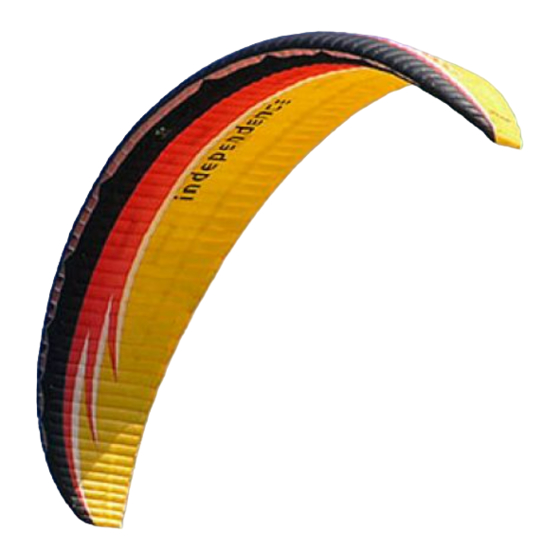
Table of Contents
Advertisement
Quick Links
Date: 10.03.2010
Manual
Revision: 0
Striker
Page: 1 of 17
Manual
Paraglider STRIKER
LTF 2-3 / EN D
Fly market GmbH & Co. KG
Am Schönebach 3
D-8 76 37 Eisenber g
Tel.: +4 9 (0 ) 8 36 4 9 8 33-0
Fax: +4 9 (0 ) 8 364 98 33-33
Email: info@ independence-world.com
Fly market GmbH & Co. KG ● Am Schönebach 3 ● 87637 Eisenberg ● Germany
Advertisement
Table of Contents

Summary of Contents for Independence paragliding STRIKER
- Page 1 Manual Revision: 0 Striker Page: 1 of 17 Manual Paraglider STRIKER LTF 2-3 / EN D Fly market GmbH & Co. KG Am Schönebach 3 D-8 76 37 Eisenber g Tel.: +4 9 (0 ) 8 36 4 9 8 33-0 Fax: +4 9 (0 ) 8 364 98 33-33 Email: info@ independence-world.com...
- Page 2 STRIKER! Please read this manual very carefully! This manual contains important information about flying and handling your new Striker. It has been compiled carefully by us and it’s not allowed to start with this wing without reading the manual.
-
Page 3: Table Of Contents
Date: 10.03.2010 Manual Revision: 0 Striker Page: 3 of 17 Table of Content: 1. Overview ......................4 2. Technical Description ..................... 5 2.1. Construction of the Glider ..................5 2.2 Line Suspension ....................5 2.3 Acceleration System ..................... 5 2.3.1 Function and Handling ..................6 3. -
Page 4: Overview
Date: 10.03.2010 Manual Revision: 0 Striker Page: 4 of 17 1. Overview Fly market GmbH & Co. KG ● Am Schönebach 3 ● 87637 Eisenberg ● Germany... -
Page 5: Technical Description
A special coating makes the wing water-repellent, UV resistant and airtight. The STRIKER consists of 68 cells. The end of the wing (stabilizer) is bent down and seamlessly integrated in the rest. -
Page 6: Function And Handling
Date: 10.03.2010 Manual Revision: 0 Striker Page: 6 of 17 2.3.1 Function and Handling Before the start the brummel-hooks of the foot-acceleration system of the harness have to be hooked to the brummel-hook of the acceleration system of the glider. It’s important to make sure, that the line runs free and is not tangled up around the riser! Before first use the length of the foot-acceleration system has to be adjusted correctly. - Page 7 Date: 10.03.2010 Manual Revision: 0 Striker Page: 7 of 17 V-max. Km/h EN/LTF Cat. 5. Ageing of Lines and Trimming Possibilities Until now belief was that lines expand during use. Concerning the middle A and B lines – which carry most of the burden – it is still true.
-
Page 8: Line Plans
Date: 10.03.2010 Manual Revision: 0 Striker Page: 8 of 17 5. Line Plans Striker S/M 27.04.2010 - Ref 2 143.5 129.5 123.5 139.5 147.5 133.5 126.5 120.5 156.5 145.5 133.5 149.5 130.5 125.5 99.5 99.5 99.5 132.5 131.5 164.5 145.5 151.5... -
Page 9: Measurement
Date: 10.03.2010 Manual Revision: 0 Striker Page: 9 of 17 6. Measurement STRIKER S/M Value Value Value Value Value Value without without without without without without Riser Riser Riser Riser Riser Riser 7870 7840 7890 7965 7935 8820 7790 7760... -
Page 10: Harness
(see in the manual of the harness).If there is any defect, you are definitely not allowed to take-off! The easiest way to take off with the STRIKER is to lay it out in an arc. You have to lay it out against the wind. -
Page 11: Checklist
The most important thing during the take-off is, like at all other gliders too, not the force but the constancy of the pull. Because the STRIKER is very easy to lift up, you have to brake it a little bit on steep takeoff areas or in strong wind conditions, to avoid that the glider is overtaking you. -
Page 12: Accelerated Flight
The opposite if you fly in downwashes (down winds): Here you pull the brake-lines dosed. 11.5. Landing The STRIKER is easy to land. At the end of the flight against the wind let it glide out while softly braking. About 1 m above the ground you should increase the angle of attack by using the brake stronger. -
Page 13: Using A Motor
For best performance and easiest take off we recommend a pre-acceleration system! 13. Using a Motor At the moment the STRIKER is not yet certified for flying with a paramotor. But several manufacturers of paramotors are planning to do this certification. The current status of the certification can be inquired from the paramotor manufacturer or directly from us. -
Page 14: Parachutal Stalls
If the canopy and the lines are in good condition, the STRIKER will speed up again automatically after 2-3 seconds. If this does not happen you must push the A-risers forward or use the speed-system of the glider. -
Page 15: Wingover
14.8. Emergency Steering In the event of losing control of the steering lines, the STRIKER can be flown easily with the rear risers (D lines). A stall happens quicker when steering with the rear risers, as if steered with the brake lines. -
Page 16: Care, Storage, Repairs And Disposal
In time the UV rays will damage the material of the paraglider. Therefore don’t leave the STRIKER out in the sun unnecessarily. Take care that the paraglider will not get dirty while laying it out. The dirt particles can damage the material. -
Page 17: Disposal
Date: 10.03.2010 Manual Revision: 0 Striker Page: 17 of 17 16.4. Disposal The materials of which a paraglider is made require a special disposal. So please send disused gliders back to us. We will care about a professional disposal. 17. Nature and Environment Actually it’s self-evident, but nevertheless mentioned particularly: Please practice our...


Need help?
Do you have a question about the STRIKER and is the answer not in the manual?
Questions and answers